- Analysis on the influence of type and proportion of aggregates on the performance of PU based polymer concrete
Zhuoyuan Chena, Jianbo Zhaoa,b,*, Peiyang Lia, Aizhong Qina, Zhihua Gaoa, Wenfen Zhaoa, Shaocan Wanga and Guanfeng Lia
aChina State Shipbuilding Corporation No.713 Institute, Zhengzhou 450000, China
bJiangsu University of Science and Technology, Zhenjiang 212000, ChinaThis article is an open access article distributed under the terms of the Creative Commons Attribution Non-Commercial License (http://creativecommons.org/licenses/by-nc/4.0) which permits unrestricted non-commercial use, distribution, and reproduction in any medium, provided the original work is properly cited.
In this work, the fabrication and improvement of a lightweight and corrosion-resistant polyurethane (PU) based polymer concrete are studied. The aggregate in traditional polymer concrete is generally crushed stone. Due to the low bonding strength between polymer matrix and crushed stone, it is easy to fall off between polymer matrix and crushed stone after long-term use, resulting in the degradation of the performance of polymer concrete. In order to overcome the low bond strength between crushed stone and polymer matrix in polymer concrete, modified polyetheramine particles were used to enhance the final mechanical parameters of PU based polymer concrete. A series of mechanical and environmental tests were carried out, and the effects of aggregates addition ratio and type on the mechanical properties of polymer concrete were analyzed. The experimental results determined the influence mechanism of aggregates proportion and type on the mechanical properties of polymer concrete, and obtained the appropriate aggregates type and addition proportion. The current work reveals that using modified polyetheramine particles as aggregates of polymer concrete can significantly enhance the bond strength and durability between polymer matrix and aggregates. The density of this polymer concrete proposed in this paper is about 1.2 g/mm3; The density of traditional polymer concrete is about 1.5-1.8 g/mm3, the weight can be reduced by 25%, and there is no problem of falling off between polymer matrix and aggregate
Keywords: Polymer, Concrete, Polyurethanes, Polyetheramine, Corrosion resistance
Cement based concrete is widely used in engineering construction (Brito, 2021) [4]; However, under high temperature, vibration, chemical corrosion and humid environment, cement based concrete might fail (Heukamp, 2003) [12]. This feature made the maintenance cost of cement based concrete very high. In order to enhance the reliability of cement based concrete, many gel materials, fiber materials and metal oxides were used in cement based concrete, thereby enhancing the reliability of cement based concrete in harsh environment (Mechtcherine, 2013; Dung, 2016; Zhang Junjie, 2018; Qiao Fei, 2010) [21, 5, 16, 25]; However, due to the degradation of cement exposed to the air over time, the mechanical properties of cement based concrete would inevitably deteriorate (Barlet-Gouedard, 2009; Peifettini, 1991) [24, 29]. In order to solve the problem of cement degradation, polymers such as epoxy resin and polyurethane were used to instead of cement, which became an effective solution (Kumar, 2016) [19]. Polyurethane (PU) based concrete was a kind of polymer concrete composed of PU matrix and inorganic aggregates (Jafari, 2018; Kiruthika, C., 2021) [18, 35]. Due to the low elastic modulus of PU matrix, PU based polymer concrete had good anti-vibration ability; Under harsh environment, PU based polymer concrete would not break like cement based concrete (Heidarnezhad, 2020; Ferdous, 2020) [11, 30]. As an adhesive, PU had short curing time, corrosion resistance, good waterproof performance and excellent bonding strength (Zhao Jipeng, 2022; Agavriloair, 2012; Torzs, 2019) [15, 20, 27]. Long time exposure of ordinary PU to ultraviolet or low temperature environment would lead to hardening, resulting in its performance degradation (Somarathna, 2018) [8]. Adding additives to PU could significantly enhance the ultraviolet resistance and frost resistance of PU, which had been verified in laboratory and engineering practice (Somarathna, 2018) [8]. Compared with cement, polymer matrix had the characteristics of high flexibility and toughness. In order to enhance its stiffness, fibers or hard particles were usually added to polymer matrix (Ma Wenbo, 2020; Saleh, 2019; Huang Hao, 2020; Lee, 2017; Chaohua Zhao, 2021) [26, 10, 23, 36]. In order to enhance the elasticity of polymer concrete, rubber particles are usually added inside it (Deredas, 2021; M. Varuthaiy, 2022) [34, 37].
In order to solve the low bonding strength between PU matrix and inorganic aggregates, many researchers focused on the surface treatment of inorganic aggregates. By applying coupling agent on the surface of inorganic aggregates, PU matrix could form a strong bond with inorganic aggregates, which enhanced the overall strength of PU based polymer concrete (Aziz, 2021; Riazi, 2020) [28, 13]. However, the application of coupling agent on the surface of inorganic aggregates would greatly increase the cost of PU based polymer concrete, so researchers began to focus on replacing inorganic aggregates with organic aggregates (Ganjian, 2009) [29]. As the PU matrix was an organic material, it could form a strong bond with the organic material, and its bonding strength was much greater than the bond with inorganic aggregates (Guo Jiahu, 2018; Z. Yang, 2009) [14, 38]. In addition, replacing inorganic aggregates with organic aggregates in polymer concrete was an effective method to reduce concrete weight.
In this work, we explored the effects of types and proportions of aggregates on the mechanical properties of polymer concrete. By using different PU matrix, the influence of different PU matrix on the mechanical properties of polymer concrete is explored. Both PU matrix were prepared by the mixed reaction of polyisocyanate and polyester polyol; The difference is that softener was added to one mixture to enhance the flexibility of PU matrix. The effects of to type of PU matrix, type of aggregates and ratio of aggregates on the mechanical properties of polymer concrete were evaluated by compression test and tensile test on samples with different formulas. Through the temperature impact test, the performance degradation of this kind of polymer concrete in harsh environment was explored. Finally, through the corrosion resistance test, the corrosion resistance effect of the polymer concrete to acid, alkali and salt was explored.
Material
Aggregates
The aggregate types used in our test are modified polyphenylene oxide particles (PPO), silicon carbide particles (SiC), high alumina porcelain particles (Alp), brown corundum particles (As) and tungsten steel particles (W); The aggregate used is a mixture of one or more of the above particles. The modified polyphenylene oxide particles are divided into two specifications: large (PPOH) and small (PPOL). The average particle size of PPOH used is 5 mm; The average particle size of other particles is 3 mm. Fig. 1 shows the grading curve for each particle. The presence of oil film and impurities in the particles may weaken the bonding strength between the aggregate and the polymer matrix. Therefore, it is necessary to clean the aggregate with 50% ethanol solution before the test, and then dry it in a 120 ℃ drying oven for 6 h. The performance parameters of each particle are shown in Table 1.
Polymer matrix
The polymer matrix used in this work is a two-component polyurethane (PU) composed of a base and a hardener. In order to explore the influence of polymer matrix on the performance of polymer concrete, two-component PU from two different companies were used in this work. The two different PU are black and white respectively, with different hardness and toughness. In order to simplify the description, the black two-component PU (U604-7, Duyu Chems Shanghai, China) is hereinafter referred to as Black PU, and the white PU (HT8666, Huitian Chems Xiaogan, China) is hereinafter referred to as White PU. The base component of the two PU adhesives is polyester polyol (PP); The hardener consists of polyurethane prepolymer containing isocyanate (-NCO) group. The base of White PU is added with softener, so the toughness and elasticity of White PU after molding will be higher than that of Black PU.
Table 2 shows the specific components of Black PU and White PU. The B component of Black PU and White PU are isocyanates, and the difference is that the composition and proportion of component A. Component A of Black PU is mainly polyester polyol and aluminum hydroxide; Aluminum hydroxide is used to improve the fire resistance of PU. The a component of White PU is mainly castor oil, polyester polyol and aluminum hydroxide. Compared with Black PU, a certain proportion of castor oil was added to component A of White PU as a softener; The addition of softener can significantly improve the tensile properties of White PU and make it have better ductility.
Sample fabrication
Aggregates preparation
The size of the samples used in this experiment is 20×45×95 mm. In order to explore the influence of aggregate type, proportion and particle size on the performance of polymer concrete under the same volume fraction (vol%); We designed 30 formulas according to the type, proportion and volume fraction of aggregate. Table 2 lists the 30 formulas.
According to the formulas in Table 3, using an electronic balance to measure the particles with the corresponding mass (measured according to the mass given in Table 3). In order to mix different kinds of aggregates evenly in polymer concrete, the measured different kinds of particles are poured into glassware and stirred with a mechanical mixer for 5min. Put the stirred particles into glassware for standby.
PU binders preparation
The curing time of black PU and white PU are 8-10 hours. There is sufficient time to mix the two-component PU with aggregates. Mix the A and B components of PU in a glass beaker according to the mass ratio of 5:1, Then use a mechanical stirrer to stir the mixure for 5 min to ensure that the two components are fully mixed. Finally, leave the mixed PU to stand for 30 min and drain the foam for standby.
Polymer concrete preparation
Using a measuring cup to measure the corresponding volume of mixed PU (measured according to the volume given in Table 3), then pouring the measured mixed PU and the corresponding aggregate into a glass beaker for mixing. The mixure was stired with a mechanical mixer for 5 min to ensure the aggregate and PU are fully mixed. Finally, the mixure was poured into the mold and compacted with a compactor. Polymer concrete samples were demoulded after 6 hours and then cured at room temperature for 24 hours.
Characterization and tests
Tensile tests
Tensile test was used to determine the tensile strength, tensile modulus and elongation at break of polymer concrete with different formulas. By comparing the tensile test data of polymer concrete with different formulations; The effects of volume fraction, type and proportion of particles on the tensile properties of polymer concrete were studied. The dumbbell shaped sample block used in the tensile test shall comply with ASTM D638-IV standard, and the sample block size is 20×45×95 mm. According to ASTM D638-IV standard, the measurement was carried out with a universal testing machine (CMT5205, SANS) with a cross-head speed of 2 mm/min at temperature of 25 ℃. Tensile strength, tensile modulus and elongation at break were obtained by tensile stress-displacement curve. The static elastic modulus of the sample is obtained by (ASTM D638–14 Standard 2014):

Where Et is the tensile modulus (MPa); F represents the tensile force when the sample is extended by 0.5 mm; S is the cross-sectional area of the sample; Δl represents the extension of the sample under F; l is the effective length of the tensile test sample.
Compression tests
In order to evaluate the compressive performance of polymer concrete with different formulas under extreme working conditions (15 MPa). According to the 30 formulas in Table 2, 30 rectangular samples with the size of 95×45×20 mm were made. In addition, we also prepared a sample block made of MPPO with the same size as the above 30 samples as the control group. A universal testing machine (CMT5205, SANS, Japan) with a loading capacity of 300KN was used to obtain the compressive stress-displacement curve at 25 ℃. Referred to the test method in ASTM 579-01 standard, the compression tests were conducted at the cross-head speed of 1 mm/min. The experimental steps are as follows:
The samples were placed with the square face of 95×45 mm upward, then press the upper surface of the test unit tightly with a preload of about 50N, and then load it to 15 MPa. Record the compressive stress-displacement curve to obtain the ultimate working condition compressibility and static elastic modulus. The static elastic modulus of the samples was obtained by Eq. (2) (ASTM 579–01 Standard 2001)

Where E is the static elastic modulus (MPa); σ2 represents the compressive stress at 10 MPa; σ2 represents the compressive stress at 5 MPa; ε2 represents the strain under 10 MPa stress; ε1 represents the strain under 5 MPa stress; s2 represents the displacement under 10 MPa stress; s1 represents the displacement under 5 MPa stress; l represents the height of the samples (20 mm).
Temperature shock tests
In order to explore the effect of temperature shock on the mechanical properties of polymer concrete with different formulas. According to the formulas listed in Table 2, The samples made of formulas No.5, No.12, No.13, No.14, No.27, No.29 and No.30 were selected for temperature shock test which used the universal temperature test chamber (GDJB-100, OBIS, China) with the range of -40 ℃~150 ℃. Referred to the test method in MIL-STD-810 F 503.4 standard, the temperature change range of temperature was setted as -40 ℃~70 ℃. Then the samples were put into the temperature box for temperature impact test, and the humidity in the process should be subject to the atmospheric humidity during the test.
The temperature changing cycle was 2 h and the number of cycles was 20. After the temperature shock test, compression tests on the samples after temperature shock test were conducted according to the method in 2.3.2; Compared the compressive stress-displacement curves of the samples with the same formula before and after the temperature shock test to evaluate the temperature resistance of of the polymer concrete with different formulas.
Corrosion resistance tests
In order to explore the resistance of polymer concrete with different formulas to acid, alkali and salt. According to the formulas listed in Table 2, The samples made from the formulas No.13, No.19, No.20, No.21, No.22, No.27 and No.30 were selected for corrosion resistance tests. Before the tests, The mass of each test samples were measured with an electronic balance (ME204, Mettler Toledo, America). Referred to the test method in ISO 2812-1:2007 standard, the above test samples were soaked in 10% sulfuric acid solution, 10% sodium hydroxide solution and 10% sodium chloride solution for 168h respectively; The surface state of the samples would be photographed and recorded every 24 hours. After the test, The samples would be washed. And then they would be dried at 25 ℃ for 2 h. Observing whether the samples surface were damaged, cracked and corroded after the tests; Then tested the quality of the samples soaked in different solutions, and compare the quality changes of the samples before and after the tests. The corrosion of H+, OH- and Cl- ions on polymer concrete with different formulas would be evaluated.
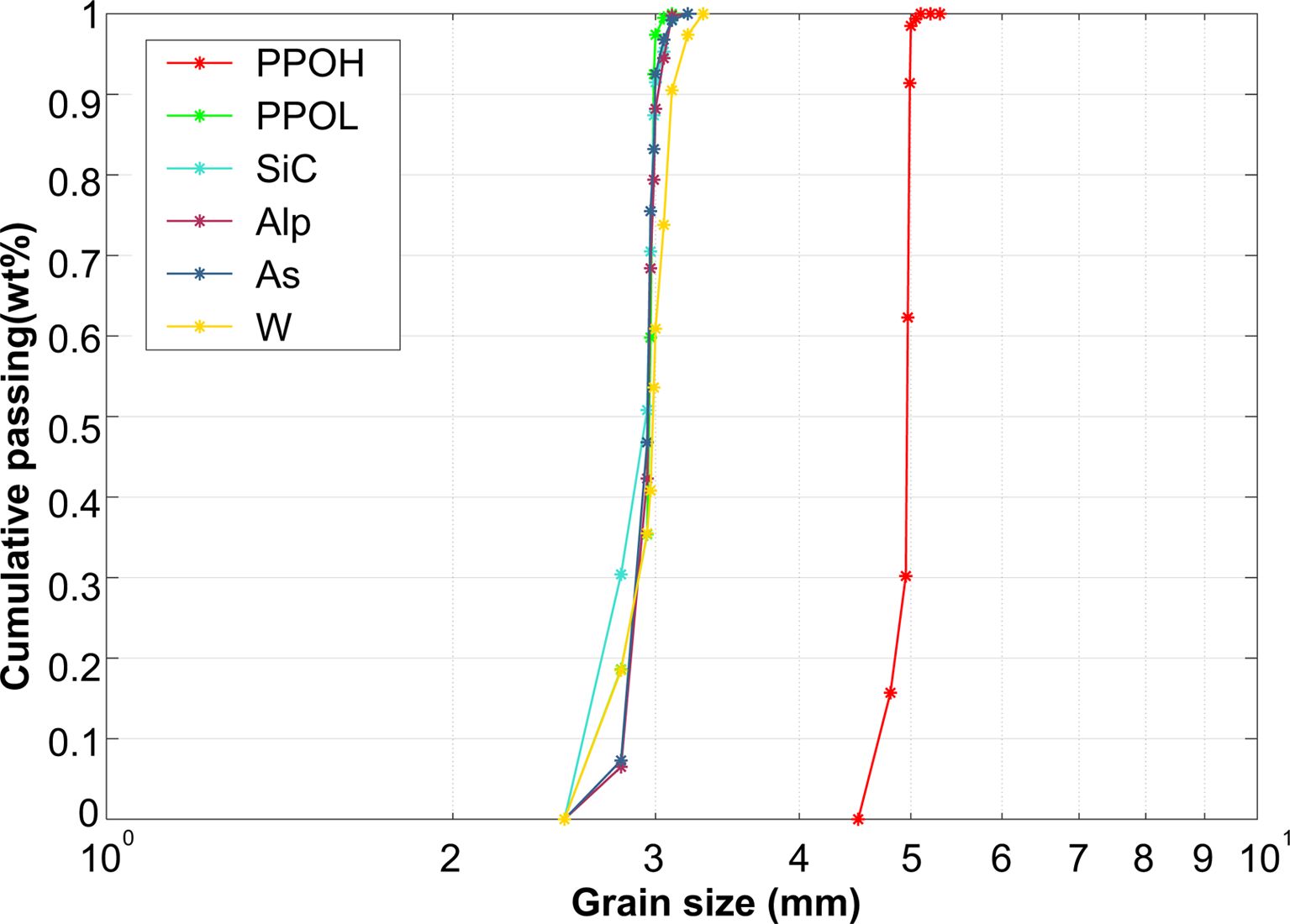
|
Fig. 1 Gradation curve of the particles. |
Tensile tests of Polymer concrete
Fig. 2 shows the tense stress-displacement curves of White PU and Black PU. The maximum tensile stress of Black PU is significantly higher than that of White PU; And the strain of Black PU at the maximum tensile stress is greater than that of White PU. This result can be explained that the softener added to white PU improves the internal stress state of PU (Lei Wenwen, 2018) [31], which can significantly reduce the internal stress of PU and conducively improve the durability of PU. However, the addition of softener also brings a side effect, which will appropriately reduce the strain of PU at the maximum tensile stress and reduce the elastic deformation ability of PU.
Fig. 3(a) shows the tensile stress-displacement curve of black PU based high polymer concrete samples relative to the volume fraction of aggregates (type: PPOH). Fig. 3(b) shows the tensile stress-displacement curve of black PU based high polymer concrete sample relative to the volume fraction of aggregate (type: PPOL). Adding appropriate proportion of aggregates to polymer matrix can significantly increase the tensile strength of polymer concrete, The reason is the strong interface between polymer matrix and aggregates (Banea, 2015; Faneco, 2017) [3, 6]. But when the volume fraction of aggregates is too large, the tensile strength of polymer concrete will be significantly reduced. When the volume fraction of aggregates added is too large, the volume fraction of polymer matrix is too small to completely fill the gaps between aggregates, resulting in a sharp decrease in the tensile strength of polymer concrete.
Fig. 4 shows the tensile stress-displacement curve of White PU based polymer concrete relative to the type of aggregates. Adding rigid particles to aggregate can increase the tensile strength of polymer concrete, The reason is the strong adhesion between polyurethane substrate and rigid particles. But it has no obvious effect on the maximum tensile strain of polymer concrete. Although adding a certain proportion of rigid particles to the aggregate can significantly increase the tensile strength of polymer concrete, this does not mean that adding rigid aggregate can enhance the tensile properties of polymer concrete. Because the maximum tensile strain of polymer concrete after adding rigid particles does not increase, under the same tensile strain, adding rigid particles will significantly increase the internal stress of polymer concrete, which will reduce the durability of polymer concrete. Table 4 shows the tensile modulus and elastic modulus of polymer concrete with different formulas.
Compressive tests of Polymer concrete
Fig. 3(a) shows the compressive stress displacement curve of PPO engineering plastics and the compressive stress-displacement curve of White PU based polymer concrete relative to the volume fraction of aggregate (type: PPOL). Fig. 3(b) shows the compressive stress-displacement curve of PPO engineering plastics and the stress-strain curve of Black PU based polymer concrete relative to the volume fraction of aggregate (type: PPOL). Compared with cement-based concrete, polymer concrete has lower static elastic modulus and higher elastic deformation. A certain amount of softener is added to White PU (refer to 2.1.2 for the addition proportion and composition of the softener), but not to Black PU; It can be seen from the curve that the slope of the compressive stress-displacement curve of pure white PU is significantly lower than that of Pure Black PU; It means that the softener can significantly improve the elastic deformation of PU. After adding 30%, 50% and 70% by volume of aggregates of PPOL to White PU and Black PU respectively; The stiffness of White PU based polymer concrete is significantly improved, and its compressive stress-displacement curve is close to that of PPO engineering plastics; However, the stiffness of Black PU based polymer concrete is not significantly improved. The reason is that the compressive stress-displacement curve of Black PU is close to that of PPO engineering plastics, so the stiffness of Black PU is not significantly improved after adding the aggregate of PPOL. Adding 30% of PPOL in white PU can significantly improve the stiffness of polymer concrete, but with the increase of aggregate addition ratio, the stiffness of polymer concrete will not be significantly improved.
There are two deformation areas before the stress reaches 15 MPa. The initial linear deformation zone (I) appears in the stress range of 1-3 MPa, which is linear with smaller slope; This area is related to the initial compaction of PU matrix. The second linear deformation zone (II) appears in the stress range of 3-15 MPa and has higher slope. This change can be explained that the PU matrix became more resistant to compressive load after initial densification. Before the stress reaches 15 MPa, there is no obvious decline in slope, and the linearity is good; It shows that under the stress of 15 MPa, PU matrix and aggregate do not have structural damage directly. It is within the elastic deformation range of polymer concrete, and its compressive strength is greater than 15 MPa.
Fig. 4 shows the compressive stress-displacement curve of White PU based polymer concrete relative to aggregate size. The dotted line in the figure indicates that the type of aggregate added is PPOH (size 5 mm); The solid line indicates that the type of aggregate added is PPOL (size 3 mm); Lines of the same color represent the same volume fraction of aggregate. Under the same aggregate volume fraction, the stiffness of the sample using PPOH aggregate is slightly higher than that of the sample using PPOL; The reason is that properly increasing the particle size of aggregate will reduce the specific surface area of aggregate, and can increase the compactness of polymer concrete, so as to improve the overall stiffness.
Fig. 5 shows the compressive stress-displacement curve of White PU based polymer concrete relative to the type of aggregates. Compared with the samples with only PPOL or PPOH, adding rigid particles (SiC, Alp, As or W) with a volume fraction of 10% (Fig. 5(a)) or 20% (Fig. 5(b)) can not significantly improve the stiffness of polymer concrete, but may reduce its stiffness. There are three reasons: firist, due to the different shapes of different kinds of particles, adding a small amount of rigid particles will increase the overall specific surface area of aggregate, which will reduce the compactness of polymer concrete, thus reducing its stiffness. Second, because the amount of rigid particles added accounts for only 10%-20% of the total volume fraction, the content of rigid particles is too small, and the characteristics of high stiffness after solidification can not be well reflected in polymer concrete. Third, the density of rigid particles is larger than PPOL or PPOH, and the sinking speed in the solidification stage is also larger, resulting in the uneven distribution of aggregates in polymer concrete, thus reducing the stiffness of polymer concrete.
Fig. 6(a) shows the compressive stress-displacement curve of White PU based polymer concrete relative to the As content in the aggregate. Figure 6(b) shows the compressive stress-displacement curve of White PU based polymer concrete relative to the Alp content in the aggregate. Adding a small amount of Alp or As particles to the aggregate can not significantly improve the stiffness of polymer concrete, but may reduce its stiffness. When the volume fraction of Alp or As particles added exceeds 30%, the stiffness of polymer concrete will increase with the increase of volume fraction. When there are only Alp or As particles in the aggregate, the stiffness will be improved compared with the polymer concrete containing only PPOH or PPOL. The reasons are analyzed as follows: firist, when the volume fraction of rigid particles is greater than a certain amount, after the polymer concrete is solidified, it will not sink because aggregate accounts for a large proportion; The aggregate distribution in the solidified polymer concrete will be more uniform, which enhances its stiffness. Second, when the volume fraction of rigid particles is large, its own characteristics of high stiffness can be significantly reflected on polymer concrete, and increases with the volume fraction of rigid particles. Fig. 7 Fig. 8
Temperature shock tests of Polymer concrete
Fig. 9(a) shows the state of the samples before the temperature impact test. Fig. 9(b) shows the state of the samples after the temperature impact test. After the temperature shock test, the surfaces of seven samples with different formulas are intact without cracking, fading and other problems.
Fig. 10 shows the compressive stress-displacement curves of seven samples before and after temperature shock test. The flexibility of pure white PU will decrease significantly after temperature shock test, while the flexibility of pure black PU will not decrease significantly after temperature shock test. For the samples with different proportions of PPOL aggregate, the degradation of flexibility after temperature shock test will be significantly weakened, and this effect will be weaken with the increase of the proportion of aggregate. By comparing the experimental results of samples with 50% PPOL and 50% Alp added to White PU; The type of aggregate has little effect on the degradation of the flexibility of the polyer concrete after the temperature impact test. The above tests also show that this type of polymer concrete has good temperature performance which is not related to the type of aggregate, only related to the proportion of aggregate and the type of polymer matrix.
Corrosion resistance tests of polymer concrete
Fig. 11 shows the state of the test sample after soaking in 10% sulfuric acid solution, 10% sodium hydroxide solution and 10% sodium chloride solution for 168 h respectively. In order to show the resistance of this type of polymer concrete to acid, alkali and salt solution better, each sample artificially creates a fracture surface to observe the influence of acid, alkali and salt solution on aggregate. The results show that the surface of the samples soaked in three solutions does not crack and fade; It shows that the PU based high polymer concrete has good resistance to acid, alkali and salt. This is due to the high hydrophobicity of PU, which makes it difficult for H+, OH- and Cl- ions to combine with the PU surface, so these ions cannot form corrosion on the PU surface. PU can form good protection for some non corrosion resistant aggregates, which makes the polyer concrete achieve anti-corrosion effect that ordinary portland cement can not achieve.
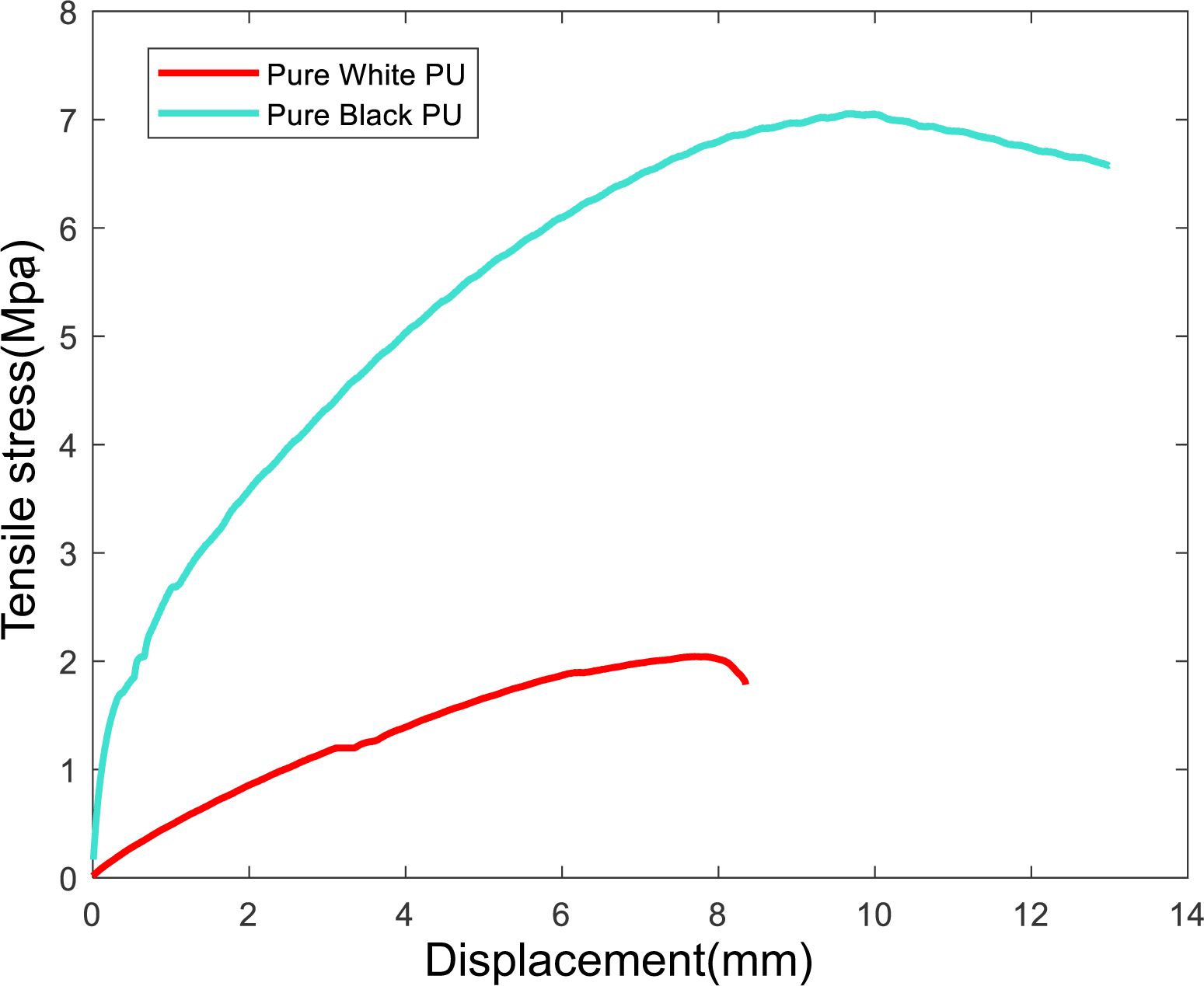
|
Fig. 2 Tensile stress-displacement curves of white and black PU. |
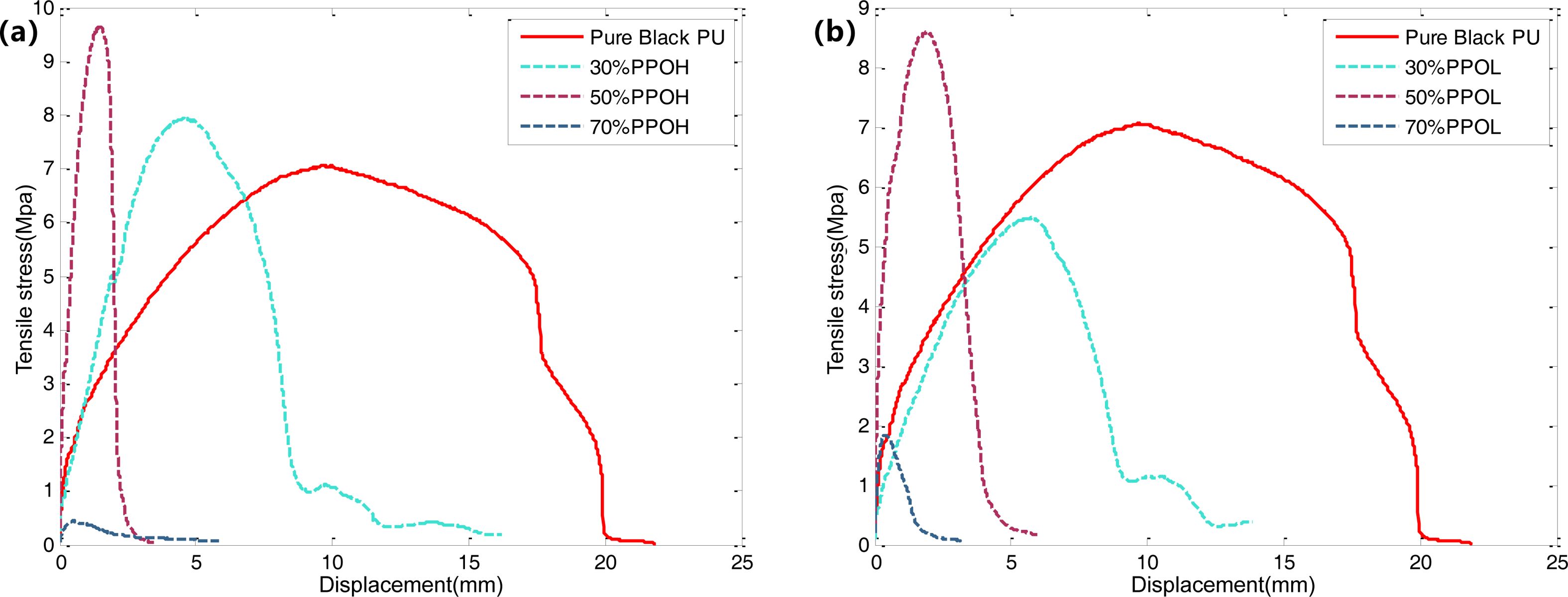
|
Fig. 3 (a) Tensile stress-displacement curves of black PU based polymer concrete with different vol% of aggregates (PPOH). (b) Tensile stress-displacement curves of black PU based polymer concrete with different vol% of aggregates (PPOL). |
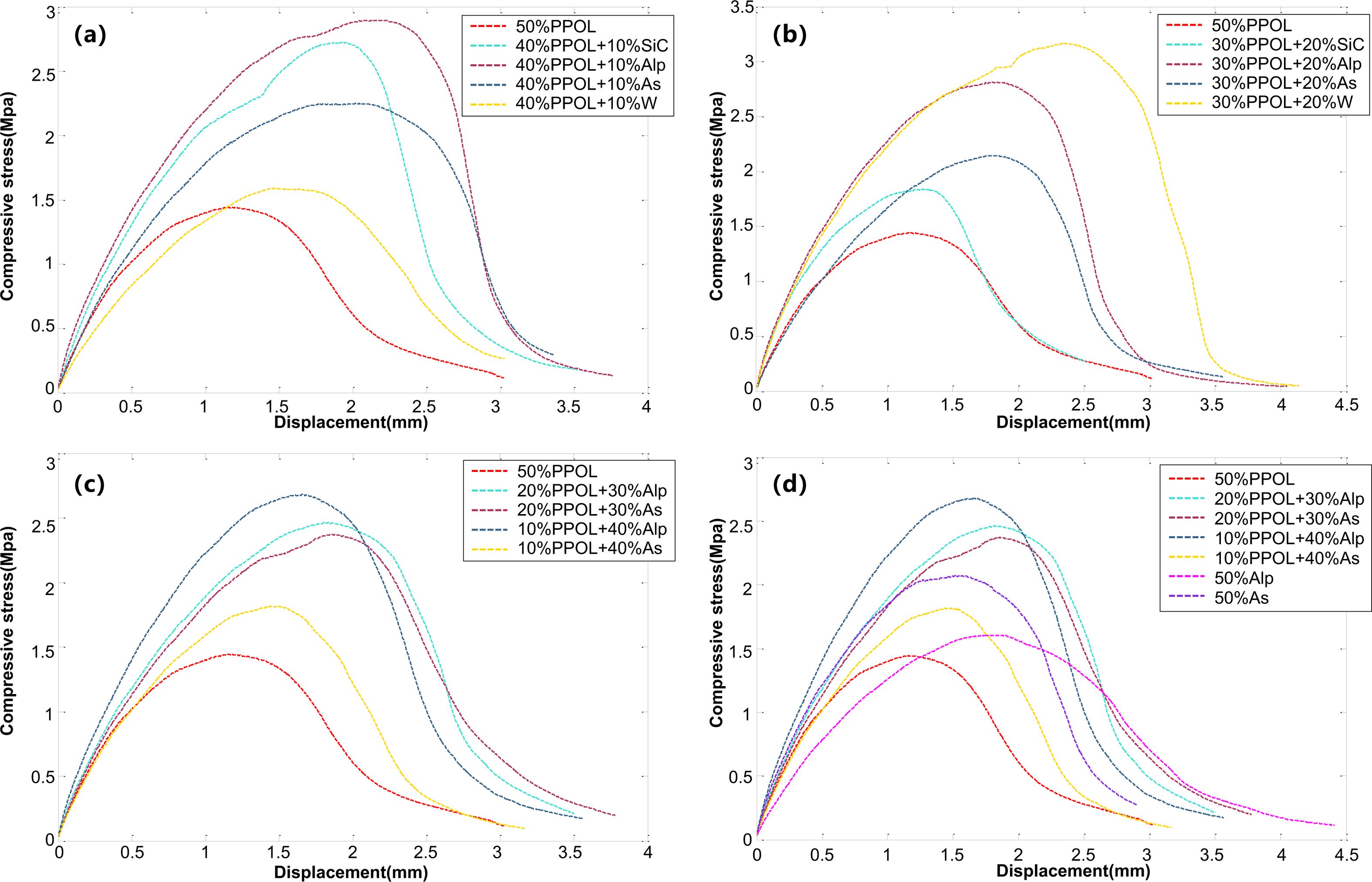
|
Fig. 4 Tensile stress-displacement curves of white PU based polymer concrete with different type of aggregates. (a) 10% rigid particles. (b) 20% rigid particles. (c) 30-40% rigid particles. (d) 40-50% rigid particles |
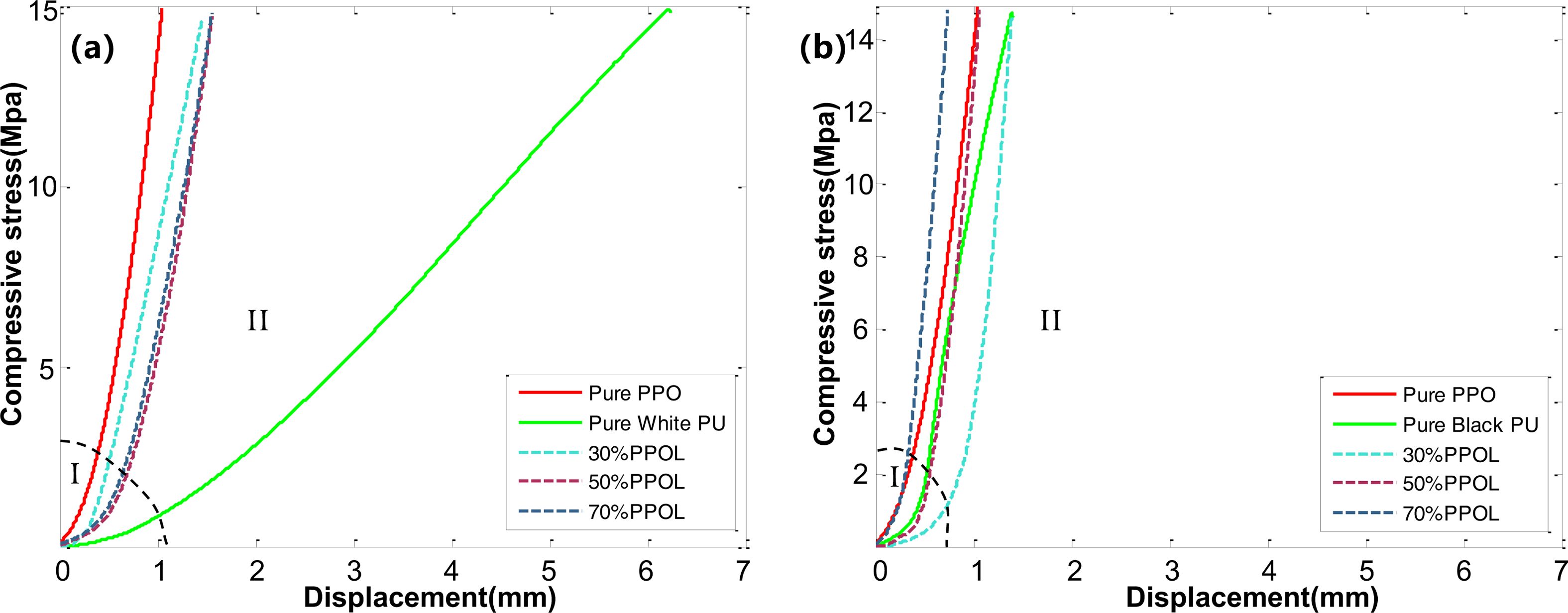
|
Fig. 5 (a) Compressive stress-displacement curves of white PU based polymer concrete. (b) Compressive stress- displacement curves of black PU based polymer concrete. |
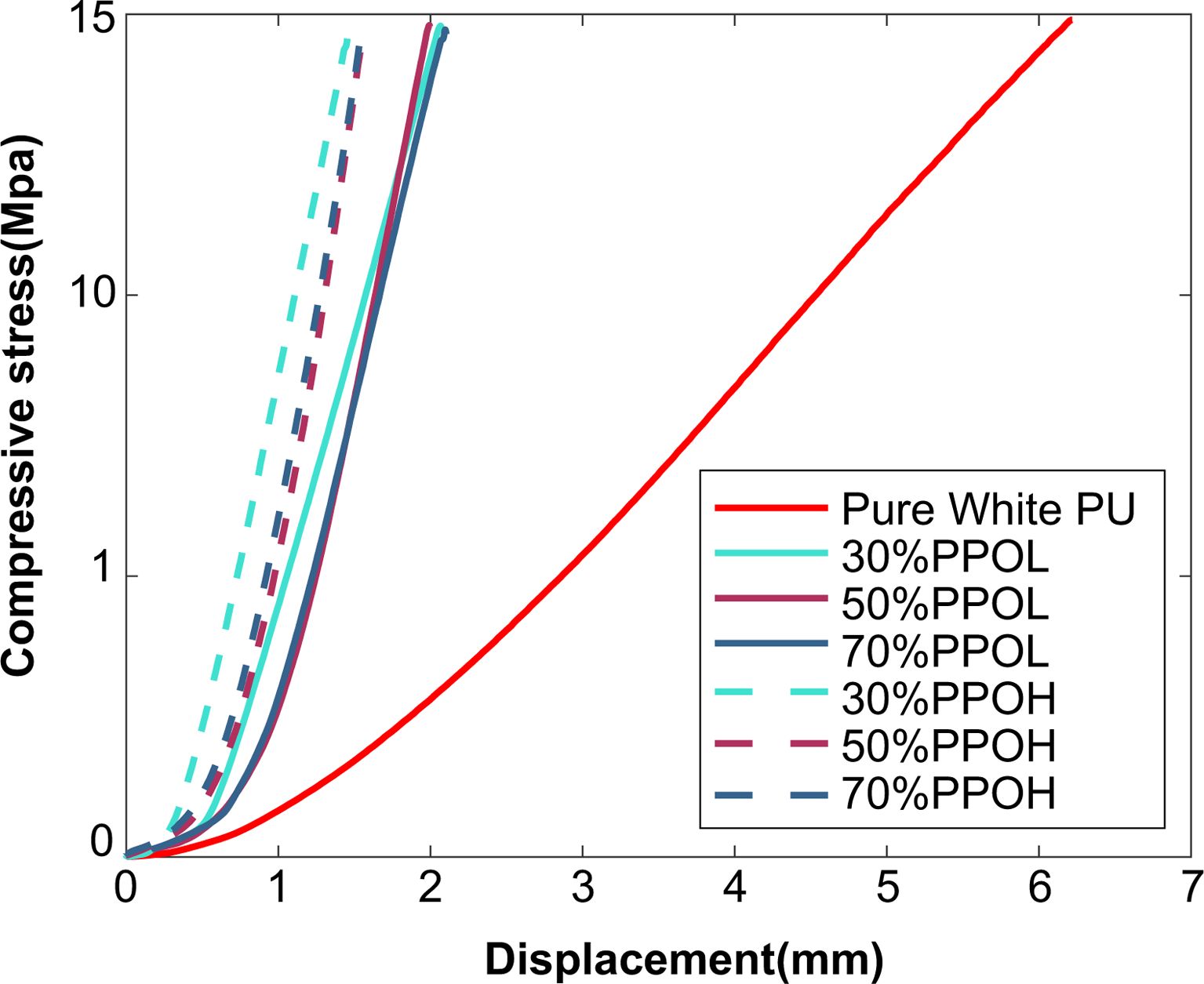
|
Fig. 6 Compressive stress-displacement curves of white PU based polymer concrete with different sizes and vol% of aggregates. |
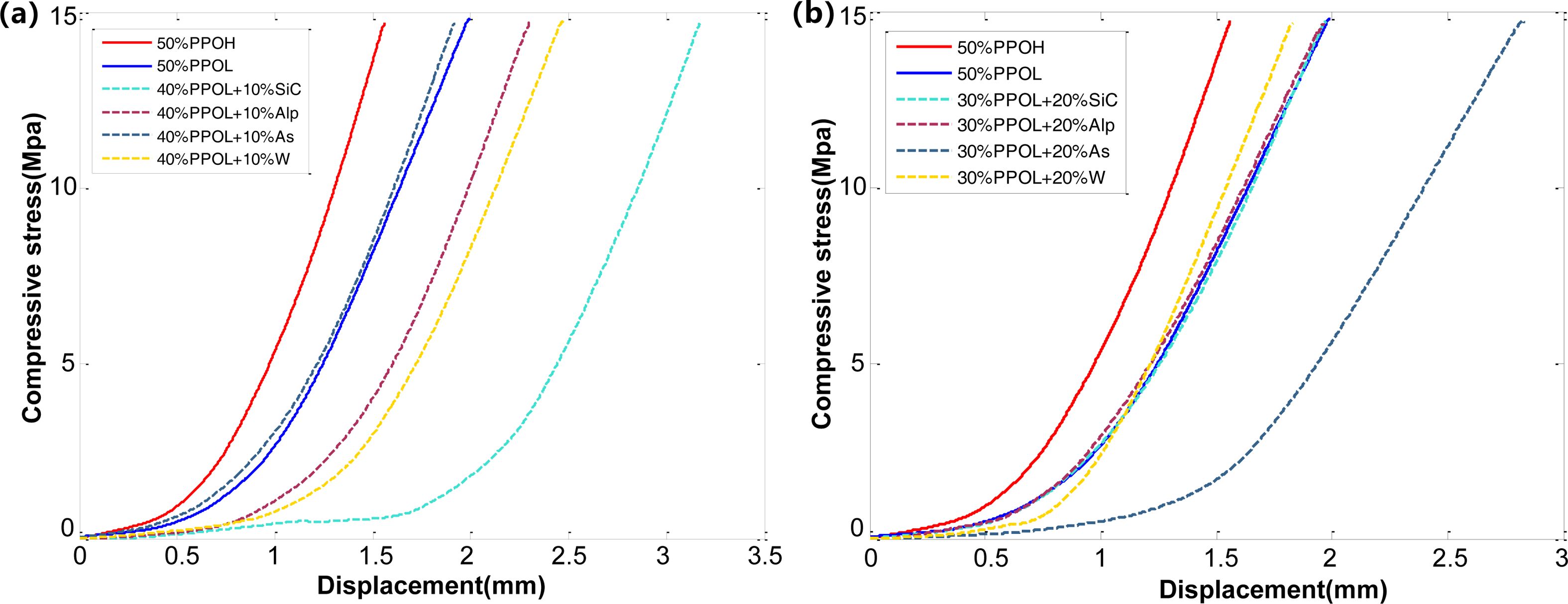
|
Fig. 7 Compressive stress-displacement curves of white PU based polymer concrete with small amount of rigid particles in aggregates. |
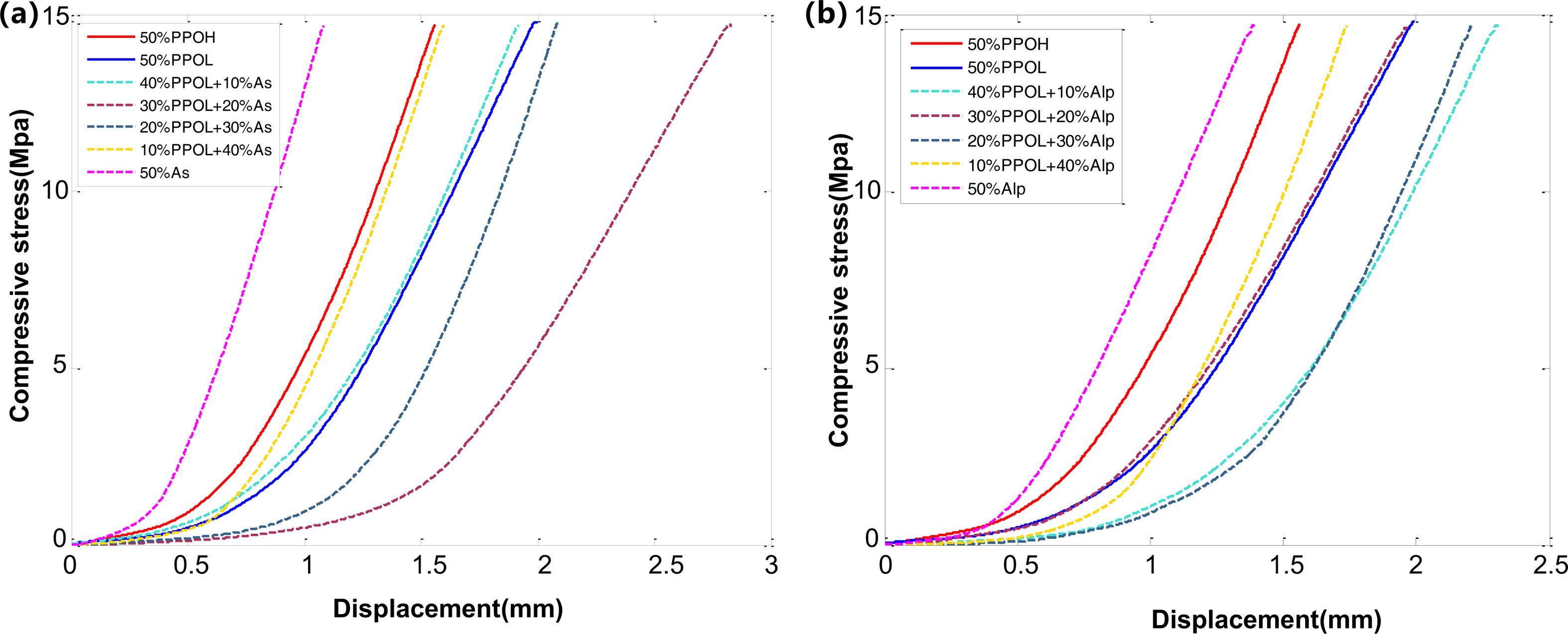
|
Fig. 8 Compressive stress-displacement curves of white PU based polymer concrete with 10%-50% rigid particles in aggregates. |
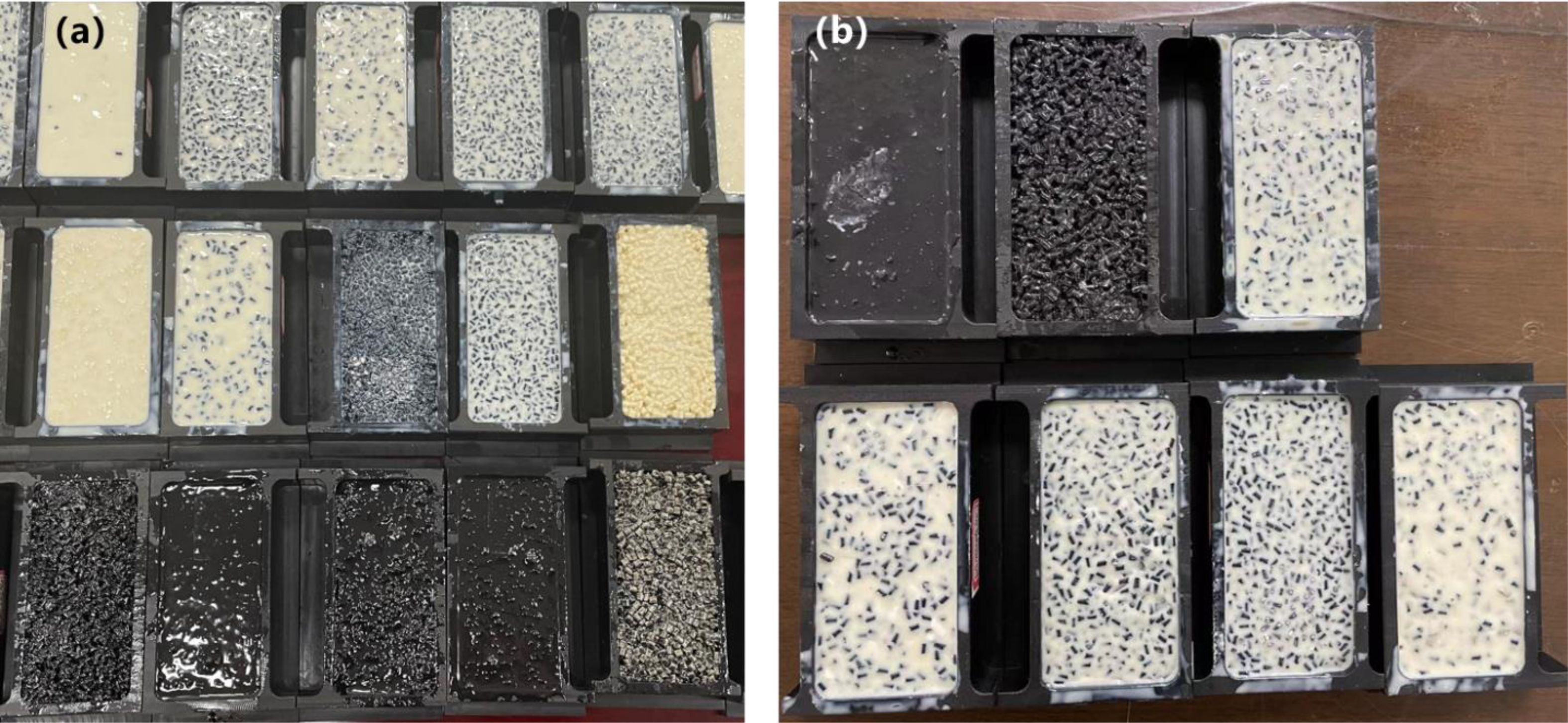
|
Fig. 9 (a) Samples before temperature impact test. (b) Samples after temperature impact test. |
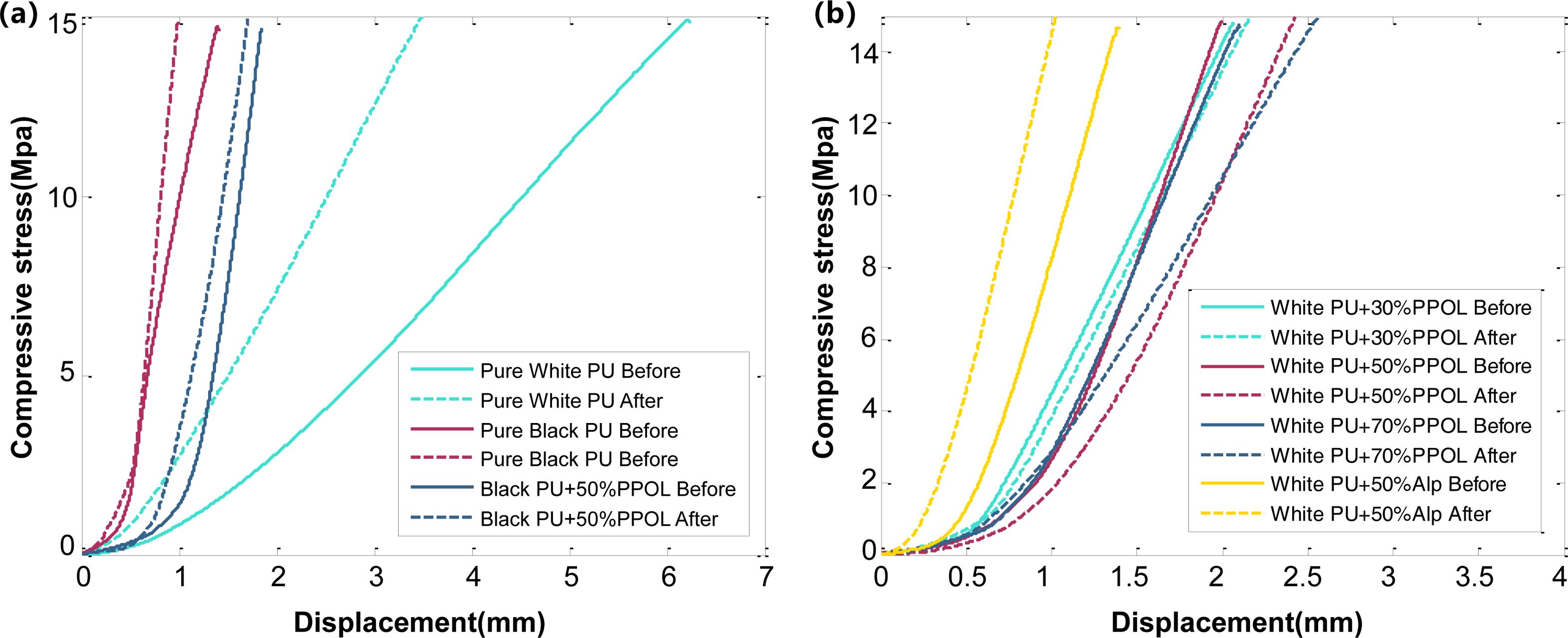
|
Fig. 10 Compressive stress-displacement curves of samples before and after temperature shock tests. |
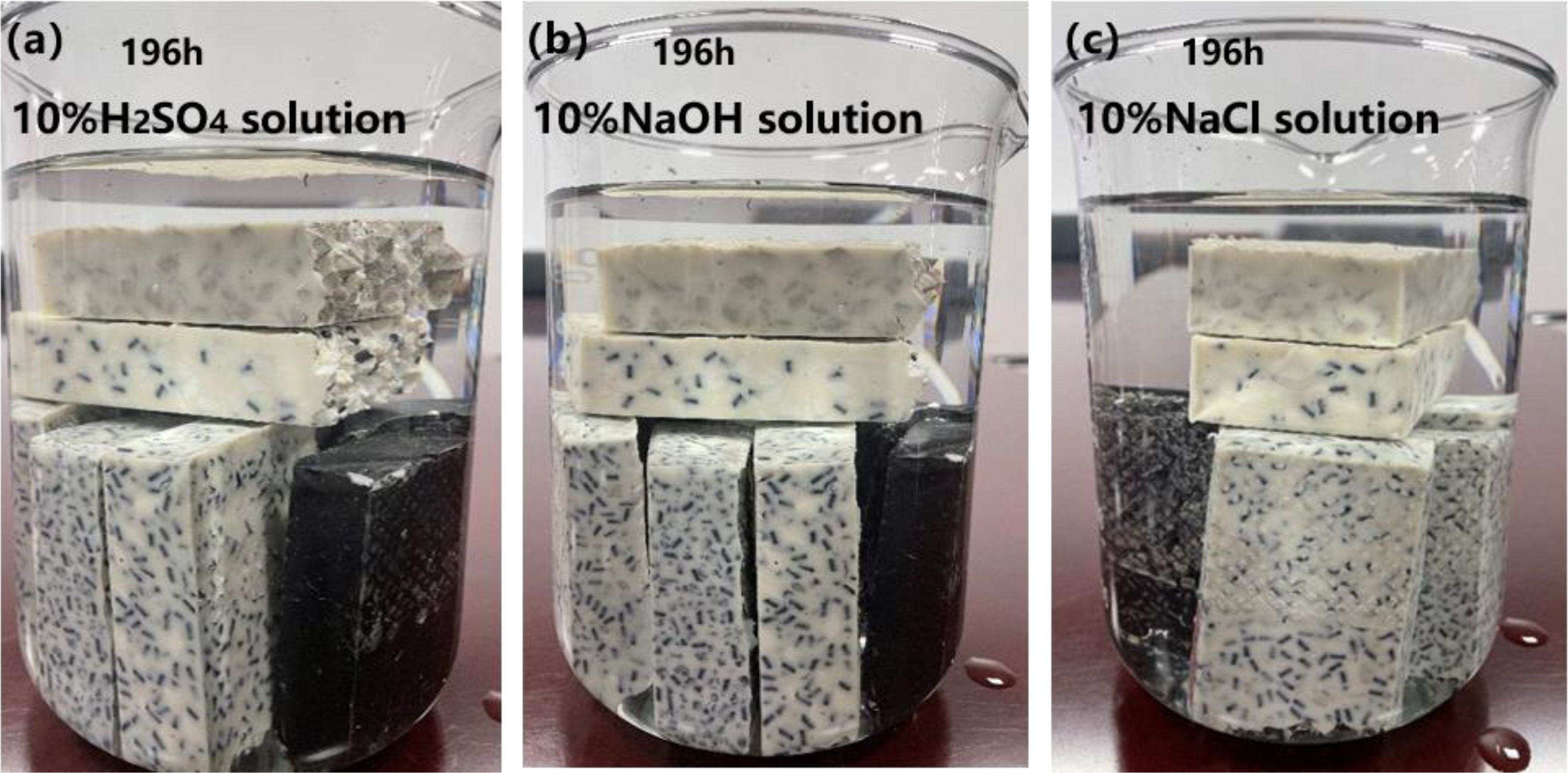
|
Fig. 11 Results of corrosion resistance tests of Polymer concrete. |
A series of PU based polymer concrete samples with different formulas were prepared in this work. The basic mechanical parameters are tested for comparison. According to the test results, the following conclusions were drawn:
1. When the type and proportion of aggregates were the same, the particle size of aggregates (3 mm and 5 mm) has no significant effect on the mechanical properties of polymer concrete.
2. With the increase of aggregates addition ratio, the compressive performance of polymer concrete would gradually increase and finally tend to saturation, but its tensile performance would first increase and then decrease; When the proportion of aggregate was 50%, its tensile properties reached the best.
3. There was no obvious difference in compressive performance between polymer concrete with inorganic rigid aggregates and polymer concrete with MPPO aggregates; However, in terms of tensile properties, the latter was obviously better than the former. And the quality of the latter was significantly lower than that of the former, which had great advantages in weight loss.
4. PU based polymer concrete was excellent in frost resistance and corrosion resistance; After the temperature impact test and corrosion resistance test, the samples had no obvious performance degradation and appearance damage.
To sum up, these research results showed that the PU based polymer concrete with MPPO as aggregates had good mechanical parameters and durability; Compared with cement based concrete, its density was greatly reduced, and it was expected to be used in harsh environments, such as ships, airports and so on.
The polymer concrete proposed in this paper still has the problems of high manufacturing cost and poor fire resistance; There is still having broad research prospects in low-cost manufacturing and fire performance optimization of such polymer concrete; In the future, we can focus on the above two issues for in-depth study, which is of great significance for the large-scale application of this polymer concrete.
- 1. ASTM 579–01, Standard Test Methods for Compressive Strength of Chemical Resistant Mortars, Grouts, Monolithic Surfacings and Polymer Concretes (2001).
-

- 2. ASTM D638–14, Standard, Test Method for Tensile Properties of Plastics (2015).
-

- 3. M.D. Banea, L.F. Silva, and R.D. Campilho, J. Adhes. 91[5] (2015) 331-346.
-

- 4. J.D. Brito and R. Kurda, J. Cleaner Prod. 281 (2021) 123558.
-

- 5. N.T. Dung and C. Unluer, Constr. Build. Mater. 126 (2016) 747-758.
-

- 6. T.M. Faneco, R. Campilho, and R.M. Lopes, J. Test. Eval. 45[2] (2017) 398-407.
-

- 7. E. Ganjian, M. Khorami, and A.A. Maghsoudi, Constr. Build. Mater. 23[5] (2009) 1828-1836.
-

- 8. H.M. Somarathna, S.N. Raman, and K.H. Badri, Constr. Build. Mater. 190 (2018) 995-1014.
-

- 9. H.M. Somarathna, S.N. Raman, and K.H. Badri, Constr. Build. Mater. 13[3] (2020) 616.
- 10. H. Huang, H. Pang, and B. Liao, Constr. Build. Mater. 242 (2020) 117221.
-

- 11. F. Heidarnezhad, K. Jafari, and T. Ozbakkaloglu, Constr. Build. Mater. 260 (2020) 119853.
-

- 12. Heukamp, F. Hoyte, Tech. Rep. - Mass. Inst. Technol. Res. Lab. Electron. (2003) 327-341.
- 13. H. Riazi, M. Anayee, and M. Soroush, Adv. Mater. Interfaces 7[6] (2020) 1902008.
-

- 14. J. Guo, T. Chai, and X. Ren. Adv. Surf. Coat. 8[5] (2018) 175.
-

- 15. J. Zhao, L. Chen, and X. Meng, Arabian J. Sci. Eng. (2022) 1-16.
-

- 16. J. Zhang, G. Li, and Z. Song, Constr. Build. Mater. 186 (2018) 1144-1153.
-

- 17. J. Zhang, G. Li, and Z. Song, Constr. Build. Mater. 191 (2018) 544-553.
-

- 18. K. Jafari, M. Tabatabaeian, and T. Ozbakkaloglu, Constr. Build. Mater. 167 (2018) 185-196.
-

- 19. R. Kumar, Rakesh, J. Polym. 13 (2016) 7249743.
- 20. L. Agavriloaie, S. Oprea, and F. Luca, Constr. Build. Mater. 37 (2012) 190-196.
-

- 21. V. Mechtcherine, Constr. Build. Mater. 41 (2013) 365-373.
-

- 22. MIL-STD-810G 503.4 Temperature Shock (2010).
- 23. M. Lee, M.H. Heo, and J. Shin, Carbohydr. Polym. 159 (2017) 125-135.
-

- 24. J.V. Perfettini, E. Revertegat, and N. Langomazino, Experientia 47[6] (1991) 527-533.
-

- 25. Q. Fei, C.K. Chau, and Z. Li, Constr. Build. Mater. 24[5] (2010) 695-700.
-

- 26. S. Saleh, N.Z. Yunus, and N. Ali, Constr. Build. Mater. 202 (2019) 738-752.
-

- 27. T. Törzs, G. Lu, and M. Oeser, Constr. Build. Mater. 212 (2019) 422-430.
-

- 28. T. Aziz, A. Ullah, and B. Ullah, J. Polym Environ. 29[11] (2021) 3427-3443.
-

- 29. V. B-Gouédard, G. Rimmelé, and J. Desroches, Int. J. Greenhouse Gas Control 3[2] (2009) 206-216.
-

- 30. W. Ferdous, A. Manalo, and P. Schubel, Constr. Build. Mater. 232 (2020) 117229.
-

- 31. W. Lei, Y. Sun, and X. Zhou, Fibers Polym. 19[5] (2018) 1024-1031.
-

- 32. M. Tabatabaeian, and T. Ozbakkaloglu, Constr. Build. Mater. 167 (2018) 185-196.
-

- 33. W. Ferdous and P. Schubel, Constr. Build. Mater. 232 (2020) 117229.
-

- 34. K. Deredas, N. Kępczak, and M. Urbaniak, Compos. Struct. 268 (2021) 113998.
-

- 35. C. Kiruthika, S.L. Prabha, and M. Neelamegam, Mater. Today: Proc. 43 (2021) 1622-1625.
-

- 36. C. Zhao, C. Hua, and J. Liu, Materials 14[21] (2021) 6234.
-

- 37. M. Varuthaiy, C. Palanisamy, V. Sivakumar, and G. Pushpanathan, J. Ceram. Process. Res. 23[6] (2022) 912-918.
-

- 38. Z. Yang, N. Ha, M. Jang, K. Hwang, and J. Lee, J. Ceram. Process. Res. 10[3] (2009) 266-268.
-

 This Article
This Article
-
2023; 24(1): 40-50
Published on Feb 28, 2023
- 10.36410/jcpr.2023.24.1.40
- Received on Jun 2, 2022
- Revised on Jul 11, 2022
- Accepted on Jul 21, 2022
 Services
Services
Shared
 Correspondence to
Correspondence to
- Jianbo Zhao
-
aChina State Shipbuilding Corporation No.713 Institute, Zhengzhou 450000, China
bJiangsu University of Science and Technology, Zhenjiang 212000, China
Tel : +86 (0371) 6713 2112 Fax: +86 (0371) 6713 2112 - E-mail: jianbo_zhao602@outlook.com








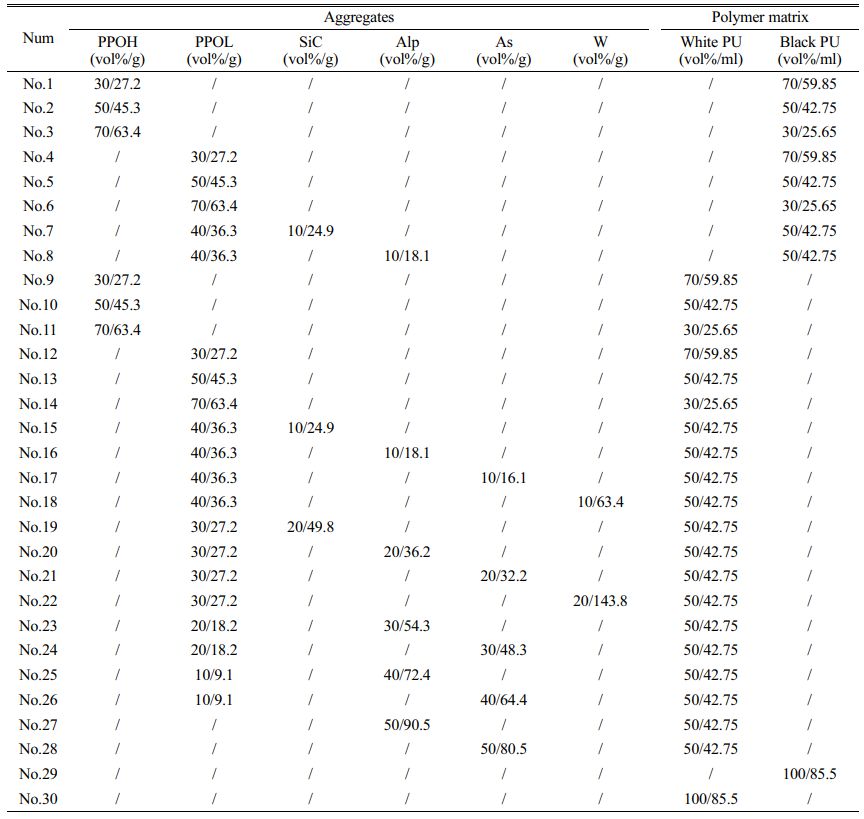
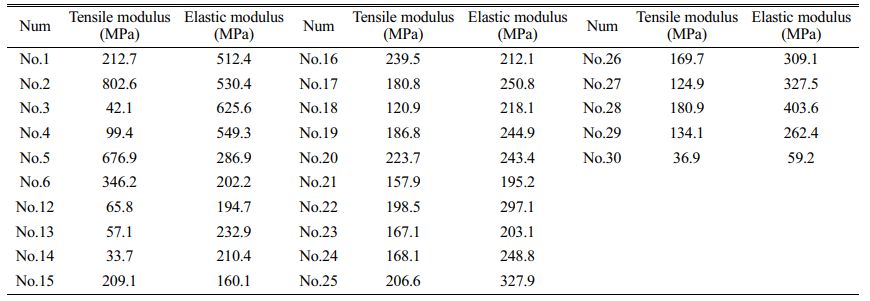
 Copyright 2019 International Orgranization for Ceramic Processing. All rights reserved.
Copyright 2019 International Orgranization for Ceramic Processing. All rights reserved.